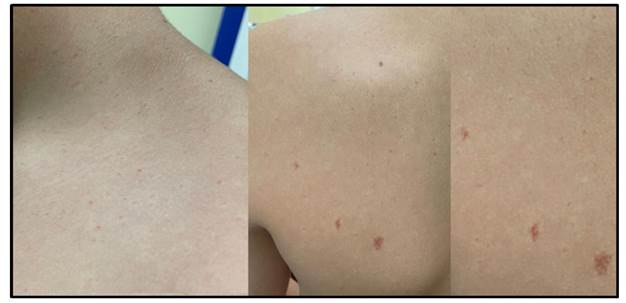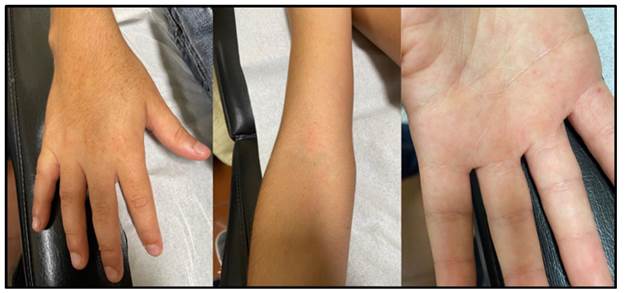The authors describe two cases of male adolescents with no relevant medical history who presented with asymptomatic clusters of telangiectatic macules. One patient had left-sided scapular telangiectasias since birth and presented with progressive development of new lesions on the upper limb and ipsilateral cervical region (Figure 1). The other patient presented with lesions on the right upper limb involving the ipsilateral dorsum and palm of the hand with 12 months of evolution (Figure 2). The lesions were completely blanched on diascopy. None of the cases had additional cutaneous lesions or other significant changes on physical examination.
What is your diagnosis?
Discussion
Unilateral nevoid telangiectasia (UNT) is a rare, benign vascular cutaneous disorder characterized by multiple, unilateral telangiectasias arranged linearly by dermatome (most commonly involving the third and fourth cervical dermatomes) or in a Blaschkoid distribution, although some cases have been reported that do not follow this pattern.1,2 The congenital form is rare, predominates in males, and persists into adulthood.1 It has not been associated with other vascular malformations or genetic syndromes. The acquired form is the most common, predominantly in females, with a peak incidence at puberty or during pregnancy and with spontaneous resolution.1 The pathophysiological mechanism leading to the unilateral distribution is not established; it is mostly related to the localized increase in estrogen receptors or their sensitivity, resulting in increased angiogenesis and telangiectasia formation.2) However, this association with estrogen levels has been disputed by some authors due to the absence of estrogen receptors in the skin and normal progesterone and estrogen levels in some cases.2,3 Based on the description of a limited number of clinical cases, UNT is rarely associated with liver or thyroid disease.1-3 In the acquired form, resolution is spontaneous after exclusion of the precipitating factor.2,3) Laser therapy is effective in unesthetic and/or persistent lesions.2-4
Disease management
In the present case, the skin biopsy was consistent with UNT. As both patients had an unremarkable medical history and no other relevant findings, no further investigation was necessary. As the lesions were small and asymptomatic, a conservative approach was taken.
Lessons from these clinical cases
UNT is an under-reported condition, and lack of physician awareness of its benign nature and lack of association with other vascular malformations may result in patients undergoing unnecessary testing or procedures. If deemed unesthetic, these lesions can be effectively removed with laser therapy.
Authorship
Pedro Marinho - Conceptualization; Investigation; Data curation; Writing - original draft; Writing - review & editing
Susana Cláudia Teixeira - Investigation; Writing - review & editing
Miguel Nogueira - Investigation; Writing - review & editing
Susana Machado - Conceptualization; Supervision; Validation; Writing - review & editing

















